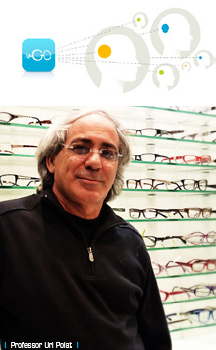By Paddy Kamen
GlassesOff1 is well named for it does just that, allowing most people between 40 and 60 to leave their reading glasses behind, for many years!
Exciting new technology from an international team of neuroscientists improves vision by leaving the eyes alone, and instead stimulating the brain’s visual cortex. The game-like training is delivered via a smart phone application (for iOS and Android devices), available for approximately $15 a month. The program involves training for three, 12-minute sessions per week over approximately three months. Users are expected to be able to read without glasses or magnifiers after 10-15 hours of training.
Nature’s Scientific Reports published the results of a study2 conducted at the University of California, Berkley that showed the aging brain can overcome, or at least delay the effects of age-related deterioration of the eyes. In some cases, subjects over age 50 who had presbyopia showed improvements comparable to the vision in the younger, control group.
Without correction:
All users became able to read a font smaller than the standard newspaper size
90 per cent of subjects regained the ability to read for longer periods without adverse effects such as headache
The reading speed of small, font-size text improved considerably
Eye age was reduced by 8.6 years.
The study was the first to conclusively prove that improvements associated with this training originate in the brain and are not the result of improved performance of the eye as might be seen in accommodation, pupil size changes or depth of perception.
 Prof. Uri Polat is the co-founder and chief scientific officer of GlassesOff. He is also the director of the Visual and Clinical Neuroscience Laboratory at the Eye Research Institute of the Sheba Medical Center, Faculty of Medicine at Tel-Aviv University. In an interview with Envision: seeing beyond magazine, Professor Polat explained that there is still some debate about how the training works in the brain to improve vision. “With age, people lose the flexibility of the crystalline eye,” he said. “The images are fuzzy, or blurred. The brain’s task is to take the information and make it reliable. My conjecture is that even though the electrical information conveyed to the brain from the eye remains less reliable, the brain becomes more efficient and faster at interpreting that information.”
Prof. Uri Polat is the co-founder and chief scientific officer of GlassesOff. He is also the director of the Visual and Clinical Neuroscience Laboratory at the Eye Research Institute of the Sheba Medical Center, Faculty of Medicine at Tel-Aviv University. In an interview with Envision: seeing beyond magazine, Professor Polat explained that there is still some debate about how the training works in the brain to improve vision. “With age, people lose the flexibility of the crystalline eye,” he said. “The images are fuzzy, or blurred. The brain’s task is to take the information and make it reliable. My conjecture is that even though the electrical information conveyed to the brain from the eye remains less reliable, the brain becomes more efficient and faster at interpreting that information.”
Blur discrimination is a function of contrast detection and so the GlassesOff training system uses contrast detection as a key aspect of its training. The app constantly monitors the contrast detection threshold and progressively increases levels of difficulty. Intervals between visual stimuli are shortened, thus training the brain to process images is faster.
The GlassesOff training is personalized for each user and begins with a vision assessment. “The vision evaluation is very sophisticated and accurate,” says Polat. “As we know, many factors can affect vision evaluation, including effort, fatigue, lighting, and the amount of time the user has to respond. So results are not always consistent from one optometrist to the next. Our test presents accurate images that look the same on any device, with images presented for limited duration. We get a very clear understanding of the user’s near-vision capability and the app will re-test from time to time as the user goes through the training.” Every session offers personalized feedback so that users can monitor their progress.
Adult amblyopia, previously thought to be untreatable, also yielded to the perceptual training developed by Prof. Polat before GlassesOff was established. In a study published in Proceedings of the National Academy of Sciences (PNAS)3, a two-fold improvement in contrast sensitivity and letter-recognition tasks was reported in patients between 9 and 55 years of age.
Prof. Polat says current applications for this technology are the ‘low hanging fruit’: “We’re not just improving vision performance, but also processing speed, decision making, reading speed and reaction times.” He expects this perceptual training to also be applied to athletic training and other tasks that depend on fast visual processing and reaction times.
1. www.glassesoff.com
2. http://www.uripolat.files.wordpress.com/2012/06/srep00278.pdf
3. http://uripolat.files.wordpress.com/2011/05/2004-polat-pnas-amblyopia.pdf








